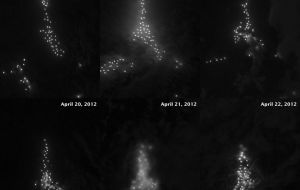MercoPress. South Atlantic News Agency
NASA solves the mystery of a “city of lights” in the South Atlantic night: jiggers
 Over the course of nine nights, jiggers shift positions while hugging the borders of EEZs of Argentina and the Falkland Islands. (Map by NASA Earth Observatory)
Over the course of nine nights, jiggers shift positions while hugging the borders of EEZs of Argentina and the Falkland Islands. (Map by NASA Earth Observatory) When in December 2012, the NOAA National Geophysical Data Center and the NASA Earth Observatory released a new map of the Earth as it appears at night they “found something fishy off the coast of Argentina” but now the mystery has been solved. About 300 to 500 kilometers offshore, a city of light appeared in the middle of the South Atlantic Ocean. There are no human settlements there, nor fires or gas wells. But there are an awful lot of fishing boats.
Adorned with lights for night fishing, the boats (jiggers) cluster offshore along invisible lines: the underwater edge of the continental shelf, the nutrient-rich Malvinas current, and the boundaries of the Exclusive Economic Zones of Argentina and the Falkland Islands.
The night fishermen are catching for Illex argentinus, that forms the second largest squid fishery on the planet. The squid are found tens to hundreds of kilometers offshore from roughly Rio de Janeiro to Tierra del Fuego (22 to 54 degrees South latitude). They live 80 to 600 meters below the surface, feeding on shrimp, crabs, and fish. In turn, Illex are consumed by larger finfish, whales, seals, sea birds, penguins...and humans.
The fishery is fueled by abundant nutrients and plankton carried on the Malvinas Current. Spun off of the Circumpolar Current of the Southern Ocean, the Malvinas flows north and east along the South American coast. The waters are enriched by iron and other nutrients from Antarctica and Patagonia, and they are made even richer by the interaction of ocean currents along the shelf-break front, where the continental shelf slopes down to the deep ocean abyssal plain.
“Squid aggregate in high concentrations at the shelf-break because it is a very productive area during austral spring and summer,” said Marina Marrari, a biological oceanographer with Argentina’s Hydrographic Service. At the shelf-break front, microscopic plant-like organisms—phytoplankton—explode in population in various seasons. This “grass of the sea” feeds zooplankton and fish, which then become food for Illex argentinus and other marine creatures.
Daytime chlorophyll concentrations on the South Atlantic Ocean surface reveal the presence of phytoplankton, which draw squid, fish, and other marine creatures to the area for feeding. Working in these high chlorophyll areas, fishermen from South America and Southeastern Asia light up the ocean with powerful lamps that attract the plankton and fish species that the squid feed on. The squid follow their prey toward the surface, where they are easier for fishermen to catch with jigging lines. Squid boats can carry more than a hundred of these lamps, generating as much as 300 kilowatts of light per boat.
Scientists first noted such night-lighting of the seas in the late 1970s and early 1980s, while compiling the first maps of the Earth at night. The images from the Operational Linescan System on the polar-orbiting satellites of the Defense Meteorological Satellite Program (DMSP) clearly showed fishing boats working the waters off of Japan, China, and Korea.
In the South Atlantic, Argentina and Falklands have exclusive rights to fish out to 320 kilometers. As the images suggest, ships from other nations work as close to that border as they can to get a share of the squid fishing.
“The satellite images are a tool to understand what is happening with the fishery, especially in international waters,” said Ezequiel Cozzolino from INIDEP, Argentina's Fisheries Research and Development Institute. “The images allow us to estimate the number of foreign jigging fleets that are fishing Illex argentinus, and to calculate the weekly captures of the species.”
Fisheries researchers and managers suggest that as much as 300,000 tons of Illex squid are harvested from the South Atlantic each year by unlicensed, unregulated fishing vessels. Managing the fishery and monitoring the presence of foreign fishing fleets is very difficult for navies and fisheries managers; the satellite views provide at least some sense of the activity in the area.
“These lights help reveal the full range, patterns, and night-to-night variability of these fishing activities in striking detail,” said Steve Miller, a Colorado State University scientist who works with VIIRS nighttime imagery. “It’s just another example of how much information exists in these measurements and how unique they are for coupling human activity with the natural environment in a way that conventional visible imagery cannot do.” (NASA).-




Top Comments
Disclaimer & comment rules-

-

-

Read all commentsNot so long ago, these “NASA” people were busy sending men to space.
Oct 29th, 2013 - 12:32 am 0I'm glad to see some Americans have come to terms with their patently evident decline, and are making the best of it to contribute in some other form.
@1 way to completely ignore the rape of the sea that should be controlled by Argentina.
Oct 29th, 2013 - 01:35 am 0If we don't rape it first, someone else will. Worked for you Brits for half a millenia.
Oct 29th, 2013 - 01:48 am 0Commenting for this story is now closed.
If you have a Facebook account, become a fan and comment on our Facebook Page!